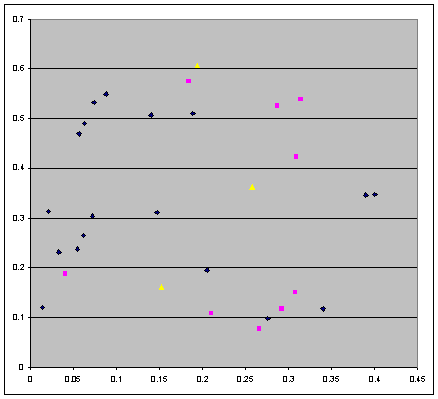 Simulation #14
Simulation #14: not only is the
second triangle congruent to
the first, but also their respective sides are parallel.
A
B =
1,
A
C = 0.921456266427119,
BC =
0.679289996641939
A'
C' =
0.999999999906395, A'
B' =
0.921456266288986,
B'C' = 0.679289996759996
A'
C'/A
B = 0.999999999906395, A'
B'/A
C = 0.999999999850092 ,
B'C'/
BC= 1.00000000017379
Moreover, A
B||A'
C', A
C||A'
B', B
C||
B'C'.
The supporting data obtained via the Taylor Center
software
The integration method for the 30 simulations used here was the same
modern Taylor method which was used by the authors in a frame of the so called Clean
Numerical Simulation (CNS) [2] at a super-computer. As the
authors wrote in [2], their implementation of the Taylor method admits
arbitrary order and double
precision. They, however, didn't mention what was the order used by
them, and what the double precision means for their super computer.
In this Taylor Center software (also with an arbitrary order) we used
the order 30 with maximum precision of float point numbers supported by
processors Intel, which is the 10 byte float type called extended:
63-bit mantissa and 16-bit exponent.
For each of the 30 computed simulations the outputted data is comprised
of the following elements:
- The header containing the sequence # of the
simulation, its half-period (taken
from [1]), and the number of integration steps;
- The initial lengths of the three edges of the
triangle denoted ao1, ao2, ao3 (computed from the coordinates taken from [1]).
- The lengths a1, a2, a3 of the second full stop.
- The "best proportions" between the edge lengths
among 3! = 6 possible permutations: "the best" meaning those closest to
1. If neither of the 6 permutation yields the proportions close to
three 1s, the message "no congruence" appears.
- The 6 values of components of the velocities in
the moment T/2 of the second
full stop posted as a proof of reaching this state and the achieved
accuracy of the full stop.
If the congruence did take place, the data package
contains also:
- The proportions yielding values close to 1, for
example
a3/ao1 =
1.00000000202946
a2/ao2 =
0.999999997920113
a1/ao3 =
1.00000000030637
- The 3x3 matrix of angles between the edges ao1, ao2, ao3 and edges a1, a2, a3 in order to see if there are angles close to 0° or 180°, for example
ao1 ao2
ao3
a1
138.847783298464°
179.999999953788° 104.361663992048°
a2 179.999999940341°
138.847783191836° 63.2094472309557°
a3 116.790552658371°
75.6383359097635° 5.33608528907246E-008°
If the angles close to 0° or 180° are detected, the pairs of parallel edges are
displayed.
Here is the actual data obtained with the
computer for the 30 samples.
Notes
on accuracy
We see that the proportions expected to be 1,
and the velocities expected to be zero, actually differ from the targeted values. The
accuracy of those values depend on several
factors: on the accuracy of the parameters provided by the author, and
on the limits of accuracy in this Taylor integrator.
In the Taylor Center software the accuracy of integration (in ideal
cases) may achieve up to 63 binary digits of the mantissa all being
correct at every step, which corresponds to 18 correct decimal digits.
Even with such ultimate 63-bit accuracy achievable at one step, the
global error increases with growing number of steps (due to the
rounding errors, or worse, due to catastrophic subtraction error in
some problems). For example, in a test for simulation #1 integrated
from 0 to its period T and
back to 0, the accuracy of the method in terms of the absolute error
was about 10-13 for the positions and 10-12 for the velocities in about
2500 integration steps.
Thinking about the reasons that the actual accuracy of the proportions
and velocities obtained in this numerical experiment is not so good,
first observation is that the values of the initial positions and the
periods were specified by the authors only up to 11 decimal digits
(instead of possible 18 in the PCs). Therefore, in order to see whether
a more accurate value of the period T
may make the velocities closer to zero at the second rest position, I
resorted to the unique feature of this software – switching between
different independent variables. In so doing, I switched from
integration in independent variable t
to integration in the velocity v3
as a new independent variable setting the termination condition v3 = 0 with the hope that u1, v1, u2, v2, u3, would get closer to zero. They did not: perhaps it's an
insufficient accuracy in the authors' given initial positions which
caused the here observed inaccuracy in the discussed values.
References



